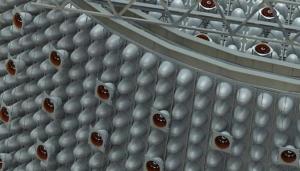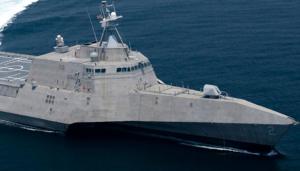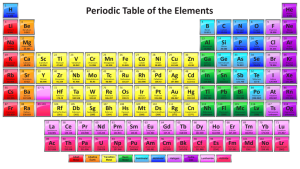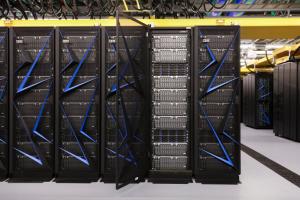LAB REPORT
Science and Technology Making Headlines
June 15, 2018


The existing Science and Technology Facilities Council’s Boulby Underground Laboratory, at a depth of 1,100 meters at Boulby mine, already hosts a range of deep underground science studies. The WATCHMAN detector would be placed in an excavated cavern at the Boulby site and is slated to become operational in approximately 2023.
Sleuthing for nuclear materials
Monitoring the use of nuclear materials is an issue of global concern. The same materials needed to build nuclear weapons also show up in power plants.
So how can international regulators ensure nuclear materials are used for peaceful purposes? Chemists are helping to develop techniques to spot illicit nuclear activity from afar and track it when it slips out of regulatory control. For example, a massive antineutrino detector called WATCHMAN developed by Lawrence Livermore could be a powerful tool to keep tabs on distant nuclear operations.
The WATCHMAN (WATer CHerenkov Monitor of Antineutrinos) antineutrino detector will perform reactor monitoring at about 25 kilometers. The latest demonstration will lay the groundwork for larger detectors that would be required to monitor or discover small reactors at distances of up to several hundred kilometers.
Carrying no electric charge and weighing more than 1 million times less than electrons, neutrinos -- and antineutrinos, their antimatter counterparts -- interact only very weakly with normal matter. As a result, they can travel through enormous amounts of material, well over a light year (9 trillion kilometers) of solid lead, without slowing down or stopping.


In California, utility companies are mandated to get at least half of their power from renewable resources, such as solar and wind, by 2030.
It’s a two-way street
With renewables on the rise, the electricity sector is going from a one-way street -- transmission line to the consumer -- to a two-way street, in which renewables such as solar and wind are pumped back into the grid and affect electricity distribution.
Traditionally, according to researchers, the grid industry has modeled transmission and distribution grids separately for planning and analysis -- electricity historically has flowed in one direction, from transmission lines to the consumers. But as distributed energy resources (DERs) such as solar panels increasingly proliferate and are integrated into the greater grid, coupling the transmission and distribution grids together into computer models has become essential to predicting grid reliability and safety.
Developing such a co-simulation requires immense computational resources, so Lawrence Livermore scientists have kicked off a two-year project with private power management company Eaton Corporation to develop and commercialize a tool capable of performing coupled simulations of transmission and distribution grids. The Department of Energy's Technology Commercialization Fund (TCF) is backing the project, with a goal of taking the software to market for the power industry to use.


LLNL researchers are lending their expertise in metal additive manufacturing to a new collaboration aimed at 3D printing critical replacement parts for the U.S. Navy
Shipshape and Bristol fashion
Researchers at Lawrence Livermore have joined forces with the U.S. Navy in a collaboration aimed at producing critical replacement parts using metal additive manufacturing (AM).
The Office of Naval Research recently announced an award of $9 million to fund the collaboration, which is led by GE Global Research and aimed at developing a rapid process for creating exact digital models of replacement or newly designed parts for naval, marine and aviation assets.
The goal over the four-year project will be to build "digital twins' from model and sensor-based data, enabling scientists and engineers to dramatically speed up the qualification and certification process of metal AM parts. The partners stated that researchers hope to eventually replace traditional manufacturing processes with AM and produce legacy replacement parts no longer manufactured by conventional methods.
Under the collaboration, LLNL will contribute its ongoing development of an intelligent, computational "feed forward" design process, which relies heavily on advanced modeling and simulation, as well as experimental analysis, to predict and teach AM systems to efficiently create parts without defects.


When element 118 was discovered, it also confirmed the existence of its descendants, element 114 flerovium and element 116 livermorium.
New kids on the block
The periodic table of the elements is one of mankind’s greatest discoveries in nature, since it encompasses all the building blocks that bind the universe.
Finding a new element is not the easiest feat. Two in particular toward the end of the table, element 114, flerovium, and element 116, livermorium, are no exception. But the road to their discovery partially involved discovering and even heavier element, 118.
In 2002, a research group consisting of scientists from the Joint Institute for Nuclear Research in Dubna, Russia, together with Lawrence Livermore National Laboratory, commenced with the first synthetic effort to produce element 118 by bombardment of californium-249 with calcium-48 ions. Calcium-48, is very rare. For a light element, it is extraordinarily neutron-rich with a count of 28, and for that reason, especially well-suited to the synthesis of stable, heavy nuclei.
After confirming the existence of element 118, the team was able to reconfirm the existence and decay properties of 118 descendants, livermorium and flerovium.


Some of the racks of computer nodes that make up the Summit supercomputer built by IBM. Photo by Genevieve Martin/Oak Ridge National Laboratory
Taking the crown...for now
The United States is now the frontrunner in the race for the fastest supercomputer in the world surpassing China, which held the title for several years.
IBM's latest machine, called Summit, is a big step forward for those who need gargantuan computing power. Unveiled last week at Oak Ridge National Laboratory, it's a top contender for fastest of the fast, a crown that will be bestowed later this month by organizers of the Top500 supercomputer list.
The system and its twin, named Sierra, at Lawrence Livermore, were funded in 2014 as part of a $325 million Department of Energy program called Coral. Sierra’s mission is mainly stockpile stewardship research to ensure nuclear weapons reliability.





